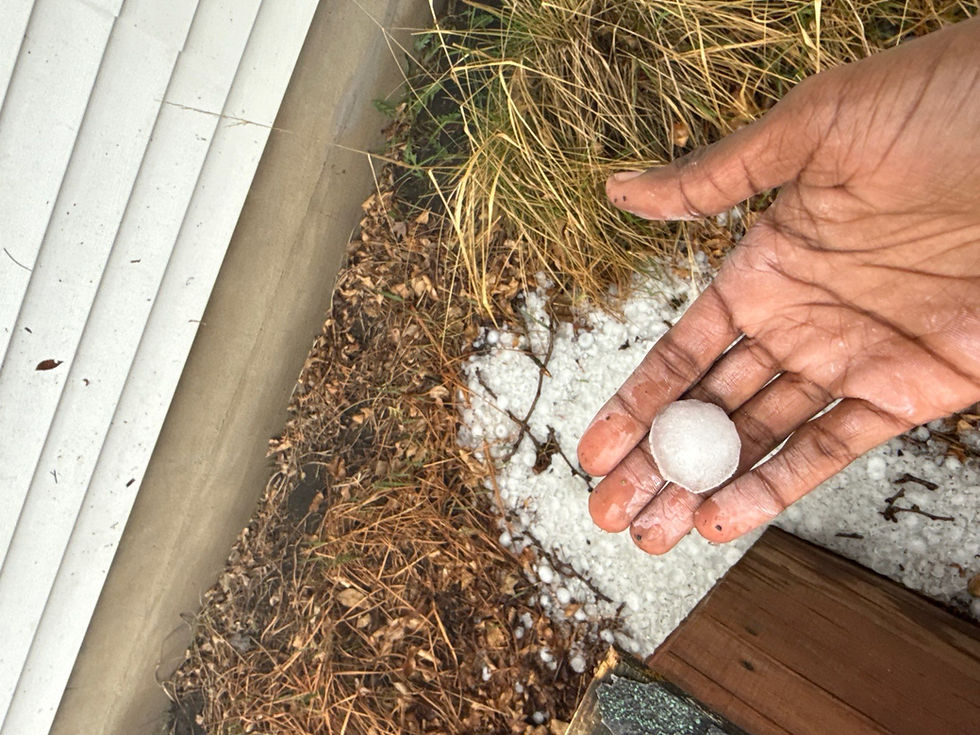Uncover the Hidden Damage: The Price of Ignoring Hail Hits on Your Roof After a Storm
- Yahara Exteriors

- Feb 6
- 3 min read
Updated: Feb 18
When a severe storm hits, it often leaves damage that can go unnoticed until it leads to bigger problems. Hail is particularly damaging to roofs, causing issues that can escalate if not addressed promptly. Recognizing signs of roof damage after a storm is essential. In this post, we will explore the indicators of hail damage, the consequences of ignoring these signs, and the importance of filing an insurance claim quickly.
Understanding Hail Damage
Hailstones can vary widely in size, from small pea-sized pellets to larger golf ball-sized impacts. The size and duration of the hail falling can significantly affect how roofs are impacted. For instance, even smaller hailstones can dent shingles, while larger ones can cause cracks and punctures.
Many people falsely assume that their roofs are fine if there are no obvious leaks. However, even minor hits can weaken roofing materials over time. According to the National Roofing Contractors Association, about 22% of homeowners experience water damage due to delayed roof maintenance, such as ignoring hail impacts. Over time, this negligence can lead to serious issues like mold, mildew, and structural integrity concerns.
Signs of Roof Wear After a Storm
To determine if your roof has suffered hail damage, you need to inspect it closely. Here are key signs to look for:
1. Dents and Dings
Look for dents or divots on the shingles. Even small dents can compromise roofing materials. For example, a single dent can weaken a shingle by up to 50%, leading to leaks down the road.
2. Granule Loss
Hail can dislodge granules from shingles, which serve as protection against UV rays and weather elements. If you find granules in the gutters or on the ground, this could indicate hail damage.
3. Cracks and Punctures
Check for any cracks or punctures in the shingles. Small openings may allow water to penetrate, potentially leading to extensive interior damage. Studies show that homes with unresolved roof issues face repair costs of 25% higher on average.
4. Shingle Curling or Buckling
Inspect shingles for signs of curling or buckling. These deformities often indicate that the shingles are failing to protect your home, leading to potential leaks if not corrected swiftly.
Consequences of Ignoring Hail Damage
Failing to recognize and address hail damage can result in several serious problems for homeowners:
1. Water Damage
The risk of water damage increases significantly if hail damage goes unattended. Small leaks can evolve into major issues, allowing moisture to seep into your home. This can lead to mold growth, which affects indoor air quality and health.
2. Increased Repair Costs
Ignoring hail damage can lead to higher repair costs down the line. What might start as a simple shingle replacement could escalate into a full roof replacement. For instance, the average cost of a new roof is around $7,500, far exceeding the cost of minor repairs.
3. Lower Property Value
Homes with a history of roof neglect can see a significant decrease in market value. Potential buyers may be reluctant to purchase a home that has unresolved roofing issues, impacting resale value by as much as 15%.
4. Insurance Complications
Some homeowners believe that insurance will cover damages if reported eventually. However, delays can lead to complications. If you wait too long and damage worsens, your claim may be denied. It's crucial to act swiftly once you notice signs of hail damage.

Taking Action to Protect Your Home
Being proactive after a storm is essential for safeguarding your roof from hail damage. By identifying damage and understanding the possible consequences, you can take necessary actions to protect your property. Ignoring hail damage can lead to significant costs and insurance issues.
Take the time to inspect your roof after a storm and file a claim if needed. Protect your home and ensure its longevity by addressing damage swiftly. Don’t wait to uncover hidden damage; act today to secure your roof for the future.


Comments